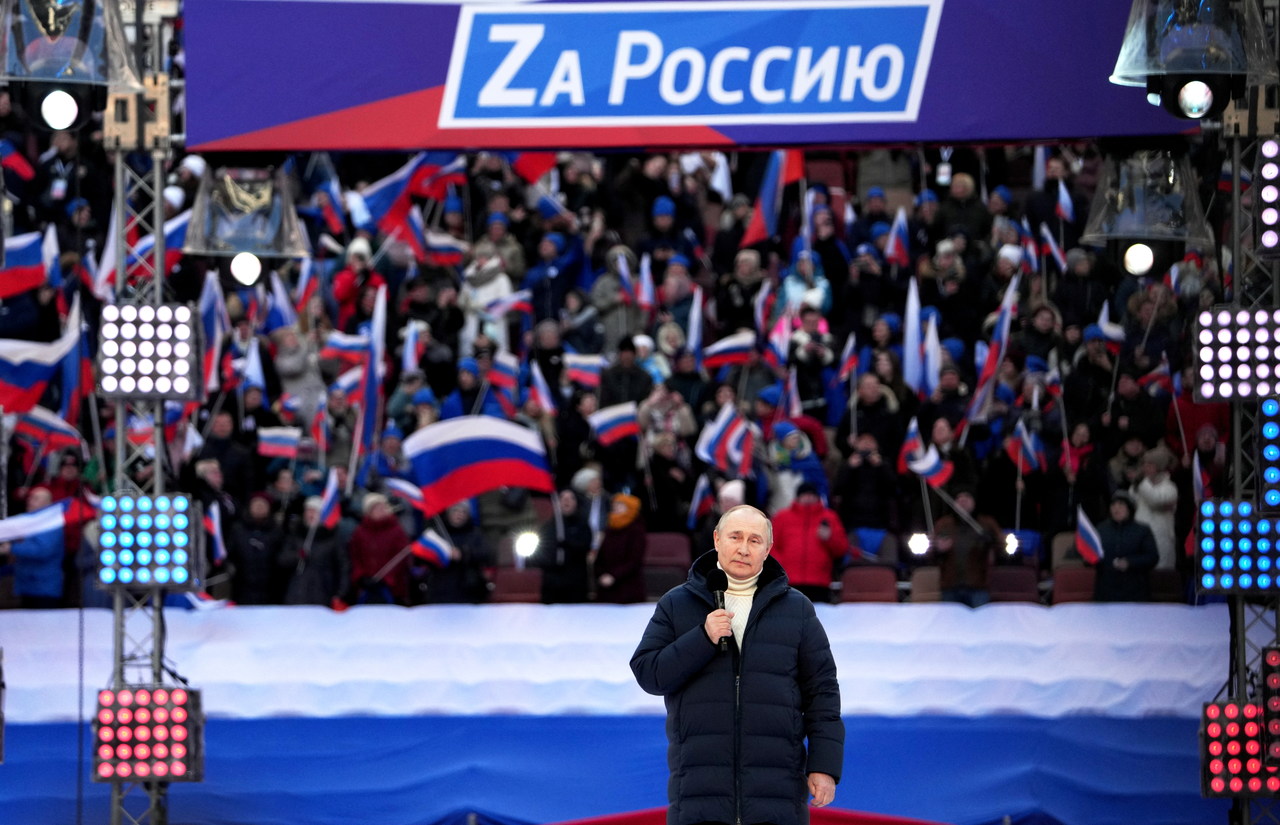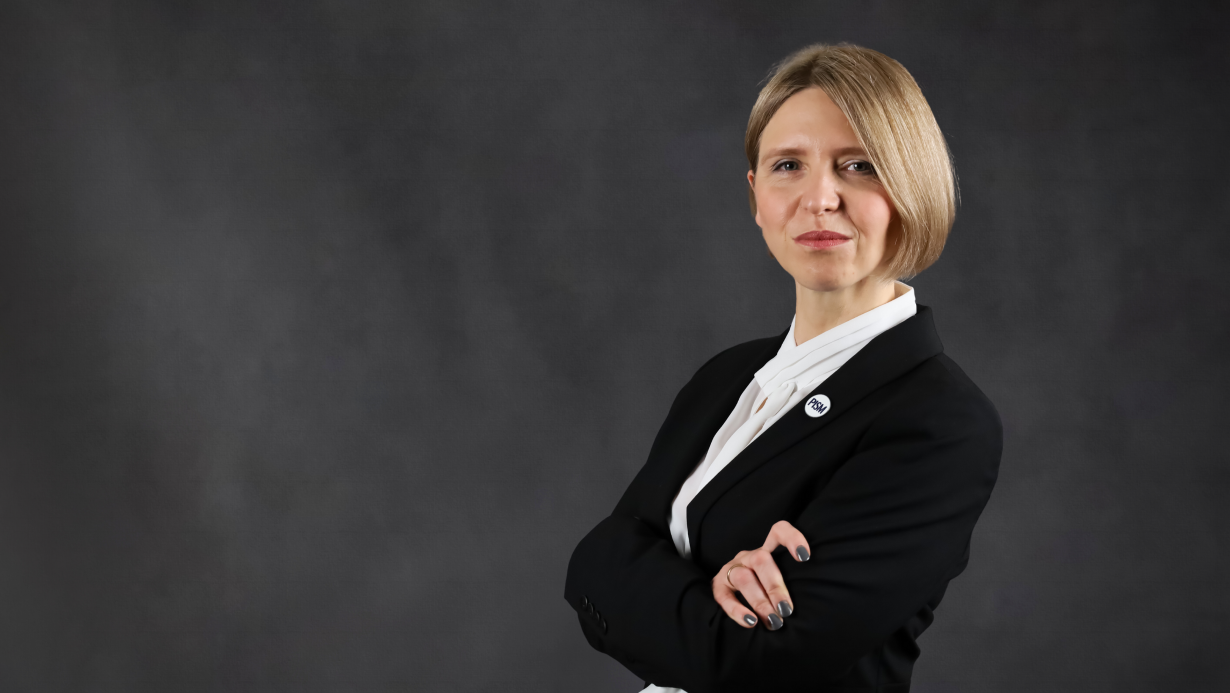Russia's Wartime Censorship and Propaganda
In connection with Russia’s invasion of Ukraine, the Russian authorities have introduced wartime censorship, forbidding the publication of content that does not conform to the official message of the Ministry of Defence of the Russian Federation. This massive and unprecedented propaganda is leading to an increase in support for Vladimir Putin, and Russians protesting against the war are being brutally repressed and persecuted. The consequence is the strengthening of the totalitarian character of the Russian state and the emigration of Russians who do not support the war. The most significant element of the Russian war propaganda is that of “denazification”, a claim aimed also at Poland.
 HOST PHOTO AGENCY/ Reuters/ FORUM
HOST PHOTO AGENCY/ Reuters/ FORUM
Censorship for War
Following the attack on Ukraine, the Russian government banned the country’s media from using the words “war” or “intervention”, ordering the use of the term “special military operation”. Under the criminal code amended in March this year, Russians can be sent to a penal colony for 3 to 15 years for “deliberately spreading false information” about the activities of the Russian military. The Investigative Committee of the Russian Federation has already initiated the first criminal cases against people who posted videos from Ukraine on social media depicting what the investigators charge is a false image of the Russian army.
This wartime censorship is mainly preventive in nature. Under pressure from the authorities, Echo, a Moscow radio station broadcasting in Russia since 1990, suspended operations even though it was the most popular station in the capital. The Dozhd television channel also suspended its activity, considering the continuation of its activities as putting its journalists and co-workers at risk. Novaya Gazeta, headed by last year’s Nobel Peace Prize winner Dmitry Muratov, provided information about the situation in Ukraine (although it avoided direct references to “war”) for the longest time before backing down. On 28 March, the newspaper received a second warning from the authorities and stopped its circulation.
The Russian authorities have also targeted social media, blocking Twitter, Facebook, and the most popular of them, Instagram (80 million users), in Russia. It was through these outlets that photos and videos of bombed Ukrainian cities were distributed. Even China’s TikTok began censoring content appearing in Russia related to the situation in Ukraine. However, YouTube, Telegram, and Facebook’s Russian counterpart Vkontakte are still active in Russia, but are obliged to provide data on their users’ activities to investigative authorities.
Propaganda
The main aim of the Russian propaganda is bolster support among Russians for the ongoing war against Ukraine. Initially, the argument of Russian media was that the “operation” was to defend the population of Donbas from alleged “genocide” by Ukrainian forces. In addition, the Russian authorities argued that it was a pre-emptive strike. Putin’s justification for the “special military operation” was to demand the “demilitarisation” of Ukraine. The Russian authorities explained this as ensuring the national security of the Russian Federation, including the defence of Crimea. The Russian government further accused NATO and the U.S. of preparing to use Ukrainian territory to allegedly attack Russia.
The second goal of the Russian propaganda is to consolidate Russian society around Putin. As hostilities in Ukraine continued, nationalist-patriotic mobilisation rhetoric began to dominate Russian media. The slogan “denazification” of Ukraine became an essential element of the media message. The fight against this supposed Nazism was devised by the Russian authorities as a reference to the symbolic and most important historical event for Russians, what they call the Great Patriotic War (1941-1945, the European part of the Second World War). Russians associate it with the victory over Germany (specifically the Nazis) and it is the founding myth of the Putin system. According to research by the Levada Centre, 74% of Russians believe that the most important result of the Second World War was the defeat of Nazism. In Russian schools since 24 February this year, teachers were given lesson plans on how to explain the “special military operation” in Ukraine to their pupils using Putin’s false argument about a fascist regime in Kyiv allegedly illegally holding power in the state.
Another aim of the Russian propaganda is to create fear and uncertainty in the societies of third countries, including Poland, because the Russian fight against “denazification” refers not only to Ukraine. During a war rally at Luzhniki Stadium attended by some 90,000 people on 18 March, Putin quoted the Bible and emphasised the “liberation” mission of the Russian army. The event was held under the slogan “World without Nazism”. According to an Active Group survey, 75.5% of Russians believe that Poland is the next country that should be “denazified”. On 21 March, on Telegram, Dimitri Medvedev, who serves as deputy chairman of the Russian Security Council, published a statement in which he attacked Poland, accusing it of “pathological Russophobia” and of “being a vassal” of the U.S. Russia is threatening countries that support Ukraine with nuclear weapons. The reality is that such threats are part of Russia’s information war aimed at getting these countries to give up helping Ukraine and not to support new sanctions against Russia. Such arguments should also be seen as part of the propaganda aimed at Russian society, which is to turn Russians themselves against Poland and Poles.
Effectiveness of the Propaganda
The mass propaganda misrepresenting the Russian aggression against Ukraine to the Russian public has strengthened Putin’s position. According to a study by the independent Levada Centre, 83% of Russians declared confidence in Putin in March. In turn, the government sociological research centre WCIOM found that 74% of Russians support the “special military operation” in Ukraine or passively accept the situation, although the result is probably deliberately inflated. Since the beginning of the war, some citizens have started to use the military symbols based on the Romanic letters “Z” and “V” in the Russian public space (such as on cars, buildings, in the metro, on clothes). In the common perception, their meaning is very broad, for example, “demilitariZation”, “Za pobiedu” (“For victory”), “Za Putina” (“For Putin”).
In the minority are those Russians who protest and speak out against Russian military action in Ukraine. They face brutal detentions (about 16,000 people so far) and other repression, including persecution, but also ostracism from the rest of society. Putin has also made accusations of internal traitors to the nation (the notorious “fifth column”), i.e., people allegedly manipulated by the West and wishing to destabilise Russia from within through their Western values. This applies, among others, to certain oligarchs with assets abroad. Given the situation in Russia, the majority of socially and politically active Russians are leaving the country (according to initial estimates, so far around 300,000 people).
However, Russian propaganda is not effective outside Russia. It has failed to dissuade NATO countries, including Poland, to stop helping Ukraine. It is also less effective because the EU has banned the Russian television channel RT and other propaganda outlets.
Conclusions
The war against Ukraine is being used by the Russian government to transform Russia into a complete totalitarian state. The introduced wartime censorship and propaganda of military successes in Ukraine have led to a strengthening of Putin’s position. The Russian authorities will enforce loyalty from the president’s closest circle, including the oligarchs, who will bear the cost of Russia’s worsening economic situation. Despite the impending economic problems in Russia due to the ongoing war in Ukraine, there will be no major demonstrations in the near future. Citizens who disagree with the situation in Russia will continue to leave the country. The authorities will probably block YouTube soon and have already restricted the use of VPNs (Virtual Private Network) to circumvent the restrictions, along with blocking most social media.
The “denazification” and fight against Putin’s imaginary Nazism is becoming an element of Russian war propaganda against Ukraine, but also against NATO countries, including Poland. This is combined with threats by various Russian authorities, implying a nuclear attack, the likelihood of which is low according to both U.S. and Polish intelligence, but which serves to create panic. The Russian authorities want to destabilise Poland and create unrest among Poles in connection with the war in Ukraine. A key task for Poland will therefore be to build social resilience and awareness in Polish society and among its allies against Russian disinformation and propaganda.


